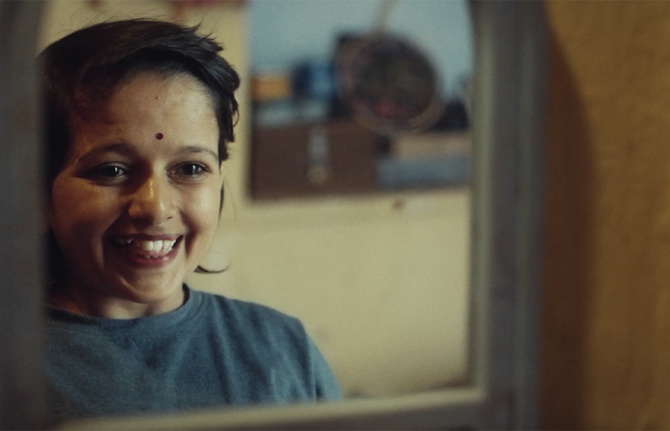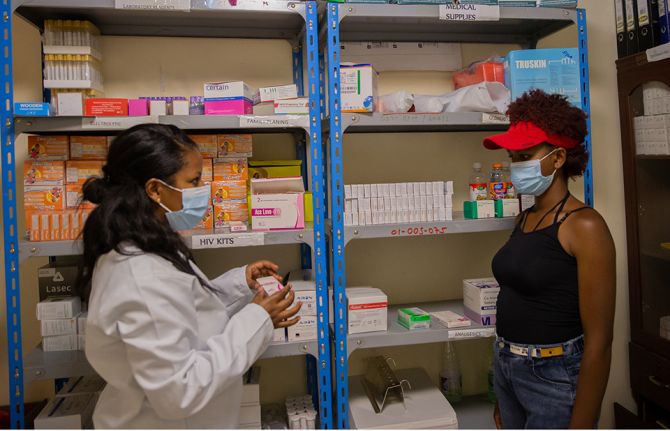

Feature Story
(Wo)man in the Mirror: seeing your true self
31 March 2021
31 March 2021 31 March 2021The night before filming began, the producer, Swati Bhattacharya, spent long hours with one of the actresses to make sure she understood the spirit of her movie.
“Because of COVID-19, I could not join, so we spoke on the phone and I told her that using no words she had to convey fright followed by acceptance,” Ms Bhattacharya said.
The film, the Mirror, portrays a young boy who is pouting and opts out of playing with other children during an Indian kite festival. His mother eggs him on, but he sneaks off downstairs alone. He drapes himself in a woman’s scarf and smiles as he sees his reflection in a mirror.
Moments later, his mother and his grandmother catch him dancing dressed up. The music stops and the women stare at the boy. A few seconds of dread pass by and suddenly the women join him.
“You see, this story plays out on many levels,” Ms Bhattacharya said. “The broad point is we have to accept children as they are and, in this case, build up their confidence.” She pointed to the fact that 98% of transgender people in India leave their homes or are thrown out. Inevitably, many live on the street with no money or education, often relying on sex work.
“Visibility is also an important thing,” the long-time advertising executive said. “Either you dislike the body you live in or you hate the society that you live in.” She wanted to capture the pivotal moment of self-recognition. Often, she explained, we look at children as our projects and want to make them extrovert and studious and obedient, refusing to see them for who they are and how they want to grow up.
“I wanted to show how they (transgender people) are seeing what they want to see and not the way the world sees them,” Ms Bhattacharya said.
Quoting an often-used phrase, she added, “It is easier to accept a child than mend a broken adult.”
In her opinion, most adults have been battered and bruised in some way or another, but transgender people in her country and across the world particularly suffer—from homelessness, from sexual violence and from mental illness.
Statistics show that transgender teenagers are much more likely to attempt suicide than teenagers whose identities match what is written on their birth certificates. In addition, transgender people face discrimination and in certain countries can be arrested. And transgender women have some of the highest rates of HIV, up to 40% in some cases.
Ms Bhattacharya knows these grim figures all too well. One of her earlier advertising campaigns focused on challenging long-time traditions of exclusion. Her team took a celebration traditionally restricted to married women and opened it to all women.
“As an ad person, I realized that we were using the cookie cutter version of an ideal woman, when, in fact, women are very diverse,” she said. Chuckling, she said that she realized that for years she had not catered to consumers like herself. That drove her to get to know more women and seek out their stories.
Not only did the Sindoor Khela campaign win accolades and awards, it opened her eyes to the diversity and also the many divides. “Married vs unmarried women, mothers vs non-mothers, divorcees vs widows, etc.,” Ms Bhattacharya said.
She wanted to bring these factions together and stressed that sisterhood is an untapped resource. Her film, the Mirror, alludes to this.
“In a way, the mother is aspirational, she is making the decision to accept her son and turning it into a celebration,” Ms Bhattacharya said. “The film has a strong feminist agenda because the two women are like a cloak, or two stage lights if you will.”
Tea Uglow, above, described the film as brazen. “Ultimately it is a fairy tale and we know it is a fairy tale and yet you wonder, what is really stopping this from being perfectly fine?” As a transgender woman based in Australia she wishes families would react just like this. What also struck her about the movie is that it has no negative emotional tones. No rage, no fear. “No one has any reason to fear a trans child… yet we are told to again and again.”
For Jas Pham, above, a transgender woman living in Bangkok, Thailand, the video struck a chord. “Basically, I teared up watching the video. It reminded me of my childhood,” she said.
She said that she focused on the child, but afterwards thought more about the mirror. “It is just a reflection; you see yourself and there is no judgement,” she said, adding that this is a powerful message of recognition and acceptance to families of transgender and gender-diverse children around the world.
Cole Young, a transgender American man, knows that parents do not always embrace their children in this open, accepting way, but he likes the positive, happy feel of the movie. “We know the bad reactions, we’ve experienced them, so we don’t need to re-traumatize trans people.”
Both work for the Asia Pacific Transgender Network, a nongovernmental organization pushing for the rights of transgender and gender-diverse people. They agreed that even though the film is filmed in India, the message is universal.
Keem Love Black, above, a Ugandan transgender woman, said the film resonated with her because at the same age she lived similar moments, and still does to this day. “I have mirror moments all the time, especially when I am going out,” she said.
Ms Black runs Trans Positives Uganda, a community organization that cares for transgender women sex workers and refugees who are living with HIV. She has used social media to raise awareness about issues concerning lesbian, gay, bisexual, transgender and intersex (LGBTI) people because few people dare speak out. Uganda criminalizes homosexuality, so she deals with persistent homophobia and transphobia among her peers and community and in health-care facilities. Reflecting upon the movie she said, “We should take up all the opportunities that come our way for visibility.”
UNAIDS is releasing the Mirror on the International Transgender Day of Visibility. Gender diversity is not a lifestyle choice but an inherent right of all people. Gender stereotypes, especially towards LGBTI people, lead to stigma and discrimination. This is more pronounced in children and adolescents, as diversity among them is not commonly understood and society puts massive pressure on them to conform to their assigned gender norms.
Above, Kanykei (who preferred not to give a last name) is one of the few transgender people who lives openly in Kyrgyzstan’s capital of Bishkek. She recalls putting on scarves when little, a bit like the boy in the film. However, her family did not take it seriously. Ever since she can remember, before she realized the difference between boys and girls, she felt like a girl. “They would laugh as in a small child is playing, but, over time, it was perceived differently, both in the family and in society,” she said.
She had to adjust her behaviour and behaved like a man. Before her grandmother’s death, five years ago, she started to consider transitioning, but she could not tell her the truth. “I lived with this gender identity conflict all the time until I decided to make the transition and live as I feel,” she said.
Ariadne Ribeiro, above, a Brazilian transgender woman, likens her own mirror moment as trying to search for herself within. That said, it scared her too. “There was always a very big fear that people might see me through the mirror as I saw myself and my secret would be revealed, and I was not ready,” she said. “I feel that the video brings a reality closer to the ideal of acceptance, something that I, at the age of 40, have not experienced.”
As a long-time transgender activist and now a Community Support Adviser at UNAIDS, Ms Ribeiro said that change is happening, but there needs to be more engagement.
That is exactly what Ms Bhattacharya aimed to show in her film. For her, when the work gains traction, that is what makes it all worthwhile. She also stressed that the “growing pains” that so many of her gender fluid friends have endured over the years are real. “I wanted to open the gates and get people to carry on the dialogue.”
Watch the film. Join the campaign #Seemeasiam on this #TransDayOfVisibility #TDOV2021.
Related
 Government ensures continuity of treatment in Malawi
Government ensures continuity of treatment in Malawi

10 February 2025


